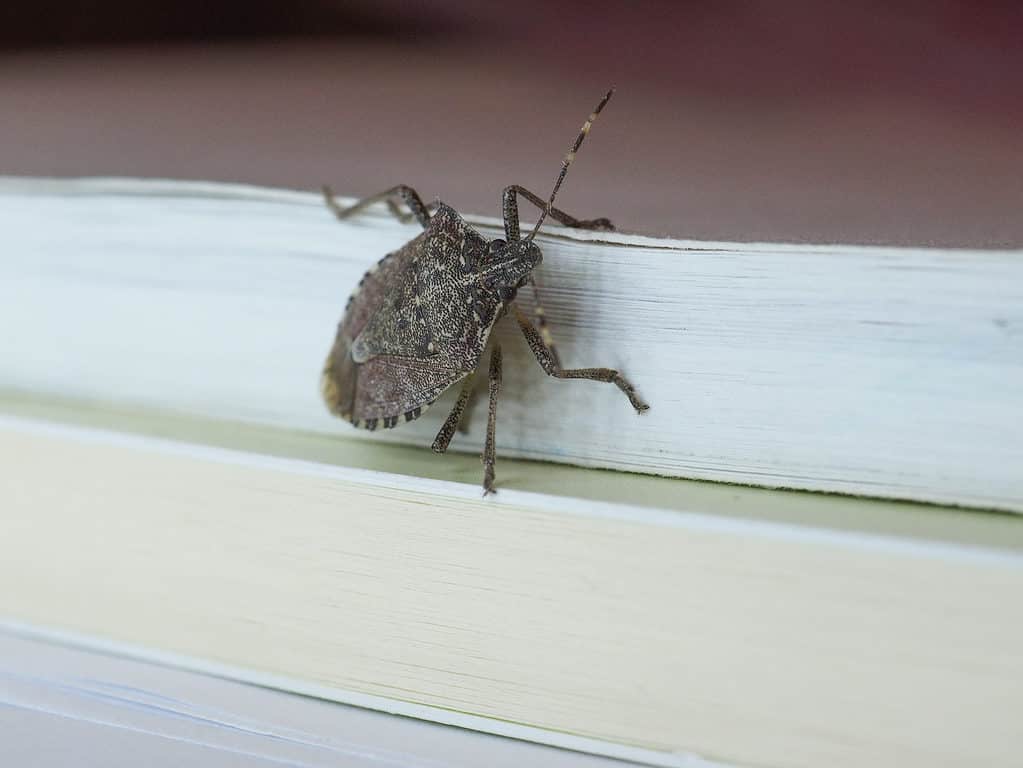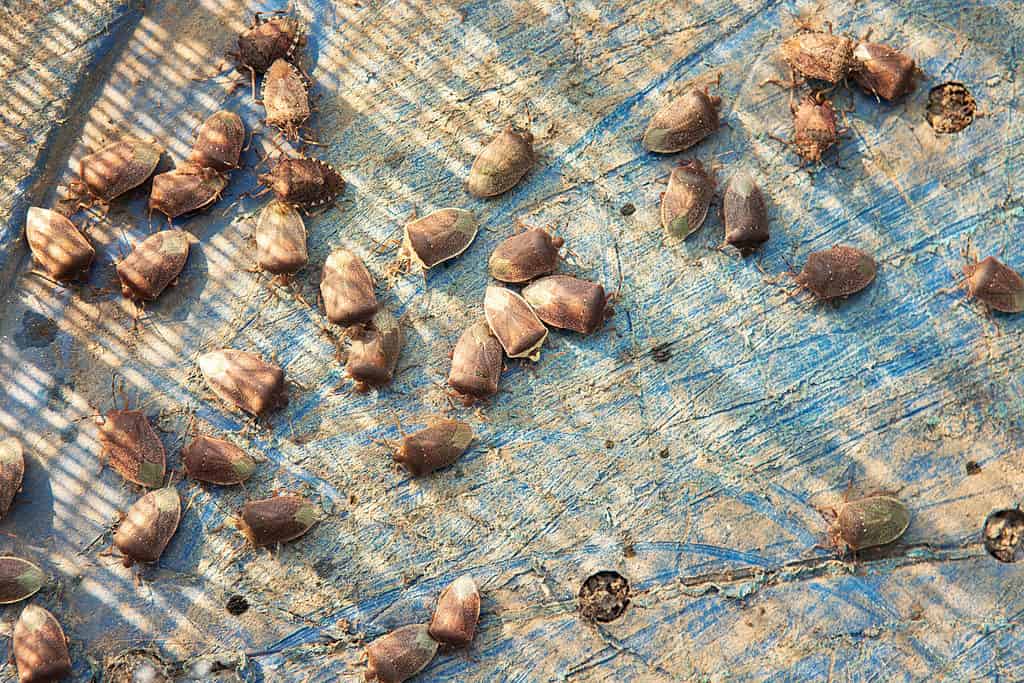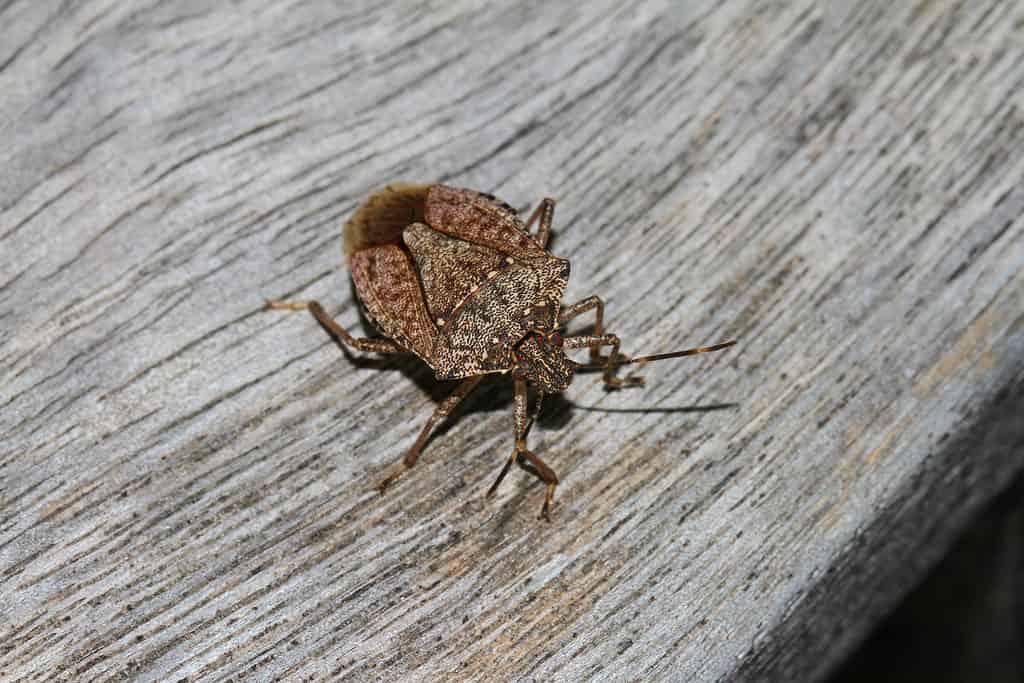Stink bugs are pungent insects so named for the foul odor they emit when threatened or crushed. More than 200 types of these stinky pests live in North America, feeding on plants and posing a threat to homeowners, especially in the winter. Knowing what attracts stink bugs and how to get rid of them can help manage infestations and save yourself from their odorous presence.
Read on for a step-by-step guide on eliminating stink bugs instantly, including how to identify the bugs, where to find them hiding, and preventative measures.
How to Identify Stink Bugs

With their unmistakable appearance, if you have stink bugs, you’ll know it.
©Claudio Divizia/Shutterstock.com
Stink bugs are tiny bugs that range in green, brown, and black coloring that are only offensive due to their horrid smell. They are dime-sized and shield-shaped, with long stick-like legs. Stink bugs can fly quickly but crawl slowly, making them easy to eliminate. However, squishing these bugs releases their smell, and there are less-stinky ways to get rid of stink bugs.
Step 1: Take the Stink Bugs Outside

If you have one or two stink bugs, the best approach is to simply take them outside. Don’t squash them!
©Jay Ondreicka/Shutterstock.com
If you notice stink bugs inside your house, it’s important not to touch or squash them, or they’ll release their infamous stench. Instead, use a plastic bag to lift them and move them outdoors, where they can be stinky in peace. Alternatively, you can drop them into a jar of soapy water or flush them down the toilet.
Step 2: Vacuum the Stragglers
Vacuums can be just as effective in eliminating stink bugs. Use a vacuum cleaner to suck in bugs out of their hiding places. You’ll usually find them hiding in window frames, wood siding, and even around light fixtures and electrical outlets. Once you’ve collected all the bugs, remove the bag and toss it in the outdoor bin.
Step 3: Use Stink Bug Traps

If you’re completely invaded by stink bugs, consider a trap.
©Cherries/Shutterstock.com
Homemade stink bug traps can be as effective as professional traps in managing stink bug infestations. A combination of dish soap, white vinegar, and hot water can effectively get rid of stink bugs, though if your infestation is more severe, more effective measures may be needed.
Homemade Towel Stink Bug Trap
Soak a towel in water and wring it until it’s damp, not sopping. Hang the towel in an open area outside of your home. The stink bugs will head to the towel to drink, and once you’ve collected enough, dunk the entire towel in a bucket of soapy water. The soap will kill them on impact; dump the water once they’re all dead. Be sure to throw the towel in the washing machine before using it again.
Homemade Soap Stink Bug Trap
Use a desk lamp with bright light to attract the stink bugs to your trap – stink bugs are naturally attracted to black, white, or blue light and will flock to the source. Place a bowl or pan of dish-soap-filled water under the lamp. The bugs will arrive at the bowl in approximately 12 hours and be killed by the soap.
Step 4: Use Homemade Stink Bug Repellant

Neem oil is a natural bug repellent.
©Wild As Light/Shutterstock.com
Keep stink bugs out of the house with a natural repellent. Neem oil gives off an aversive aroma that stink bugs try to avoid, making it a highly effective pest preventative. Spraying neem oil around the house and its perimeter will deter them from sneaking into your home.
Another option, though less effective and somewhat risky, is to squash stink bugs outside your house. The smell they emit will serve as a warning sign for other stink bugs and keep them from coming near the danger site. However, the stink can attract other bugs and potentially invite another type of infestation.
Sometimes, however, the infestation will be severe enough that you’ll need to bring in the big guns. The average chemical spray contains deltamethrin, which kills stink bugs. Apply these sprays at entry points and around window frames, or wherever the bugs commonly congregate.
Step 5: Remove What Attracts Stink Bugs

Stink bugs are big fans of fruit.
©GAME Jean/Shutterstock.com
Stink bugs may appear to materialize out of nowhere, but there are a few likely culprits to which you can attribute their arrival. These bugs love ripe fruit, so a bunch of ripe bananas could be sounding the siren call. They also feed on various garden and native wild plants, so gardeners are especially likely to need to deal with these pests. Removing fruit and preemptively protecting your gardens can help mitigate stink bugs’ bites and odors.
Step 6: Prevent Stink Bugs

Stink bugs sneak into warm places, like wall crevices, for warmth during colder months.
©Ruth Swan/Shutterstock.com
Stink bugs also have lower activity in the winter, sneaking into warm wall crevices or attics for warmth from the outside cold. Once the temperature warms again, stink bugs emerge from their “slumbers” and appear, becoming more active. Take steps in the fall to prevent them from invading in the first place, like sealing windows with caulk and addressing any apparent openings.
Exterior lighting may also attract the invaders, as stink bugs are mesmerized by white or blue light. Try switching to outdoor bulbs to more yellow bulbs or sodium-vapor lights, which are reported to be less enticing to bugs.
The Bottom Line
While a stink bug infestation poses an uncomfortable problem, preventing and removing these tiny bugs from your home is relatively easy. Thankfully, the bugs are slow-moving and simple to dispose of, with the above steps as a handy starting point. With a few tricks and a generous helping of preventative measures, your stink bug problem will be a thing of the past.
The photo featured at the top of this post is © Cherries/Shutterstock.com
Thank you for reading! Have some feedback for us? Contact the AZ Animals editorial team.






